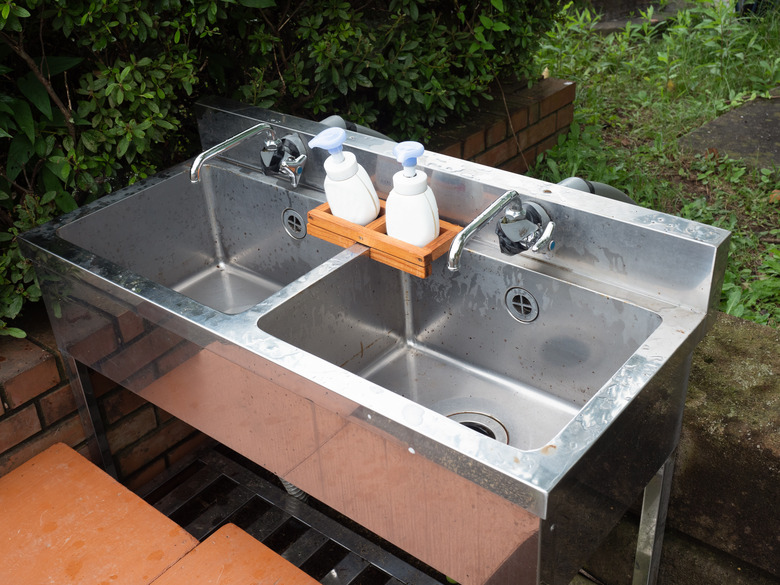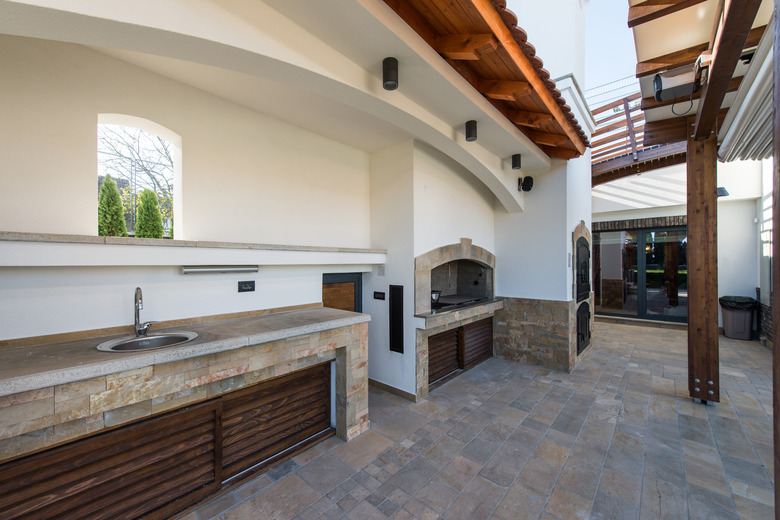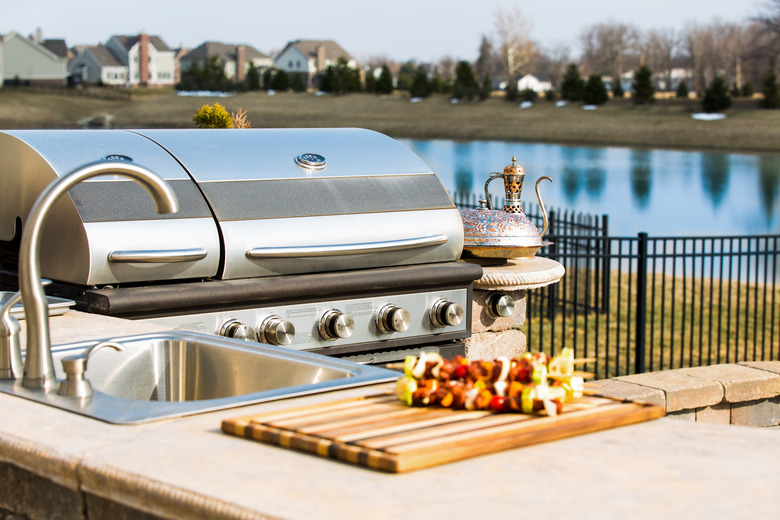Choosing An Outdoor Kitchen Sink
We may receive a commission on purchases made from links.
If you're adding an outdoor kitchen to your home, choosing an outdoor kitchen sink is one of the easier decisions you'll make. Indoor sinks are made to resist water and corrosion. As such, most indoor sink materials have no trouble standing up to snow or rain when used outdoors, giving you lots of sink options. If you're still nervous about leaving your sink exposed to the elements, however, many outdoor sink manufacturers make covers to protect the sink when it's not in use. These covers do help to keep twigs, leaves and other outdoor debris from finding their way into your sink.
Beyond the physical materials you'll need to choose for your sink (including faucets), you'll also need to figure out the best way to connect an outdoor sink to your existing plumbing, which may require the services of a professional plumber.
Outdoor Kitchen Sink Materials
Outdoor Kitchen Sink Materials
Both indoors and out, stainless steel sinks are very popular. Durable and low maintenance, a stainless steel sink is an excellent choice for an outdoor kitchen. Be mindful of the sheen, however. A bright and shiny stainless steel sink can reflect a lot of sunlight into your eyes when you're working outdoors. It's best to opt for brushed stainless to reduce the sheen or choose a darker sink material.
Like stainless steel, granite and quartz sinks both work well outdoors. Made from a composite of stone dust and acrylic resins, quartz and granite sinks are extremely durable and able to well withstand the elements. Be aware, however, that these sinks are heavy and hard. You may need to beef up your countertops to support their weight, and you'll want to be gentle with your dishes. Glassware dropped into a hard granite sink is almost always going to break.
Concrete outdoor kitchen sinks are another heavy but durable option. Concrete sinks are customizable and can be made in just about any size or shape you want. The surface will weather over time, but many feel that this simply adds to the character of the sink.
You can also opt for a solid surface sink that can integrate seamlessly into a solid surface countertop. Solid surface sinks come in a dizzying array of color choices, are nonporous to resist staining and require no more care than a wipe down with soapy water.
If you're willing to put in a bit of maintenance, consider a copper sink. Copper is durable and attractive, and a quality copper sink will last many years. You will, however, need to clean your copper periodically with a little vinegar or copper cleaner to keep it from oxidizing and turning green. It's of note that copper turns green much more quickly when exposed to salt. If you're installing an outdoor kitchen at your beach house, a copper sink isn't the best idea.
Outdoors, it's probably best to avoid enamel sinks. The enamel coating on these sinks does a great job of protecting the sink underneath, but enamel can chip and crack fairly easily. You don't want a hail storm, fallen tree branch or errant baseball to damage your sink.
Choose Your Basin
Choose Your Basin
Again, the choices you make for your outdoor kitchen sink will prove similar to those of an indoor option. You'll need to decide how many basins you want your sink to have. One large basin makes it easy to scrub large pots and pans, but a double sink gives you more options. You can, for instance, fill one basin on a double sink with ice and cold beers during an outdoor party and still have a usable sink.
You may also wish to consider a bar sink for your outdoor kitchen. Bar sinks are often a bit smaller, but they take up less counter space because of it. Bar sinks are also easier to find in fun shapes like circles or long rectangles. Bar sinks often have built-in compartments for garnish, like lemon wedges, as well as bottle openers, towel hooks and drink wells that make it easy to tend bar for your guests.
Outdoor Kitchen Faucets
Outdoor Kitchen Faucets
Like the sink itself, the faucet on your outdoor kitchen sink needs to withstand the elements. Stainless steel and copper faucets are both readily available and withstand outdoor use well. Whatever faucet you choose, remember that it must be made from a sturdy, corrosion-resistant material, just like your sink.
You'll also have to choose a faucet style. First, you need to determine if you want hot and cold water from the tap or if cold water alone will work for you. The faucet should swivel if you have a large sink or more than one sink basin. You must also determine if you want a sprayer. If you do, you'll choose between a separate sprayer or one that pulls out of the faucet.
Go high when choosing an outdoor faucet, giving serious consideration to a goose-neck faucet. You may find yourself washing larger items outdoors, such as barbecue grill racks. You'll want to leave yourself ample room between the top of the sink and the faucet to do so more easily.
Mounting and Plumbing
Mounting and Plumbing
Outdoor kitchen sinks mount in the same manner as their indoor counterparts. Drop-in sinks, as their name suggests, drop into a hole in your countertop from above. Drop-in sinks have an edge that sits above the counter, but they're the easiest type for DIY applications.
You can also choose an undermount sink. These sinks hang under the counter, eliminating the raised ridge around the sink. It's much easier to sweep water and debris off the kitchen counter and into an undermount sink, making them a good choice when paired with a garbage disposal. If you've chosen solid surface countertops, you can ask your countertop maker to build a seamless sink right into your countertop.
If you feel comfortable mounting your sink yourself, there's really no reason not to do so. Plumbing, however, is a different matter entirely. When installing an outdoor kitchen sink, you'll need to run water supply lines to the sink. Depending on the climate where you live, these lines will need proper insulation with pipe wrap or foam sleeves so they don't freeze in the winter.
You'll also need to install some type of drain system for your sink. It's important to get this right so you don't have problems every time you try to use the sink. You can provide drainage by digging a dry well about 10 feet away from the sink. Fill the dry well with a trash can or container full of gravel and then run a drain line from the sink to the container.
You can instead opt to have a licensed plumber patch your drain into your home's sewer system. This can become costly, however, if your outdoor kitchen sink and your home's drainage system are very far apart.
If you're adding an electrical device, such as a garbage disposal, getting the plumbing right becomes even more critical since you'll have electricity and water quite close to each other. Make sure you use an electrical wire rated for outdoor use and install your garbage disposal on a ground fault circuit interrupter (GFCI) outlet to reduce the risk of shock.
There are also building codes that dictate the right way to install plumbing and electrical work. Local rules may also require a permit to install an outdoor kitchen sink. Unless your DIY skills and knowledge are over the top, it's usually best to hire a plumber for this part of the job.
Outdoor Kitchen Sink Cost
Outdoor Kitchen Sink Cost
As is true of most home improvement projects, the more top-of-the-line you go, the more the project will cost. You can, for example, purchase a basic double-basin 304 stainless steel sink for about $120. Granite and quartz sinks can be had for $200 to $250, while copper is higher with a starting price of around $500. Prices quickly escalate from there depending on the size and style of the sink you want, so shop carefully. High-quality faucets average about $250, but like the sink price, faucet prices can quickly escalate depending on what you want.
If you call a plumber to install your sink for you, expect to pay around $70 to $120 per hour at minimum. In some areas, plumbers charge more. How long your installation will take depends on how far from your home's water supply the sink will be and how far away it is from the sewer system for drainage.


